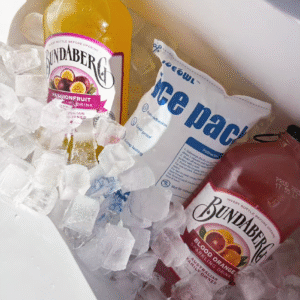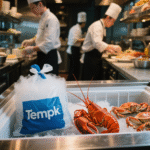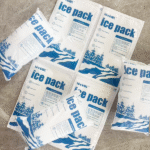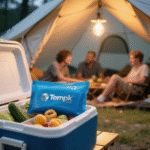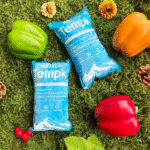Paquet de 24 Pack de glace carbonique: De combien avez-vous besoin?
Vous voulez un clair, réponse pratique. UN paquet de 24 sac de glace carbonique peut contenir des charges utiles petites à moyennes gelées pendant 24–48 heures dans un expéditeur correctement isolé. Commencez avec une règle de dimensionnement testée, valider avec un essai sur route courte, et ajuster à la chaleur ambiante et à l'espace vide. Ce guide associe des raccourcis de calcul à des conseils pratiques d'emballage afin que vous réduisiez les réclamations et les frais d'expédition..
-
Choisissez la bonne quantité en utilisant des règles simples et un estimateur rapide (24couche de neige carbonique à cellules en quart de travail).
-
Disposez les paquets pour plus d'uniformité avec des méthodes haut/bas ou en anneau (expédition congelée 48 heures en quart de travail).
-
Rencontrer 2025 sécurité et étiquettes sans suremballage (Étiquette de glace carbonique UN1845 en quart de travail).
-
Adaptez-vous à la saisonnalité avec des ajustements d’isolation et un refroidissement hybride (Isolation EPS vs VIP en quart de travail).
paquet-de-24-glace-carbonique-pack-2025
Comment dimensionner un paquet de 24 bloc de glace carbonique pour les couloirs de 24 à 72 heures?
Réponse courte: Utilisez l'un des deux points de départ-soit un règle de volume pour des feuilles à 24 alvéoles ou un rapport liquide de refroidissement/charge utile pour les formes mixtes, puis validez avec un enregistreur. Pour feuilles à 24 alvéoles, commencer à ~1 feuille par 5 à 8 L pendant ~24h. Pour la mise en kit basée sur des ratios, cible 25–50 % de liquide de refroidissement par rapport à la masse de la charge utile pour 24 à 48h.
pack_of_24_dry_ice_ice_pack_art…
Pack_of_24_Dry_Ice_Ice_Pack_Tem…
Pourquoi ça marche: La chaleur s’infiltre dans votre box au fil du temps. Une meilleure isolation et des vides plus petits ralentissent cette fuite, donc pareil paquet de 24 sac de glace carbonique dure plus longtemps. En été ou pour des trajets de 48 heures, ajouter des packs ou épaissir l'isolation de 10 mm; en hiver, vous pouvez réduire le liquide de refroidissement en toute sécurité après un essai surveillé.
Pack_of_24_Dry_Ice_Ice_Pack_Tem…
Quel estimateur devriez-vous utiliser pour la planification de première exécution?
Règle (24‑feuilles de cellules): Feuilles ≈ (Volume_L ÷ 7) + facteur transit/jour ± ajustements pour la chaleur et l’isolation.
Cela simplifie les calculs et vous rapproche de la plupart des voies parcellaires.. Commencez ici pour les fruits de mer, kits de repas, ou échantillons cliniques dans des cartons doublés de mousse.
pack_of_24_dry_ice_ice_pack_art…
| Estimateur | Saisir | Sortir | Ce que cela signifie pour vous |
|---|---|---|---|
| Règle de volume | Litres internes & heures | Draps nécessaires | Planification rapide pour les formats à 24 cellules; ajouter 1 drap par jour supplémentaire.
pack_of_24_dry_ice_ice_pack_art… |
| Règle de rapport | Masse de charge utile & voie | Liquide de refroidissement % de charge utile | 0.25–0,50 : 1 couvre 24 à 48 heures chez les expéditeurs EPS/VIP.
Pack_of_24_Dry_Ice_Ice_Pack_Tem… |
| Tampon de sécurité | Saison & ouvertures | +10–25% packs | Couvrir les quais chauds, ramassage à midi, ou des analyses supplémentaires.
Pack_of_24_Dry_Ice_Ice_Pack_Tem… |
Conseils et choix prêts à l’emploi
-
Maximiser les contacts: Panel la charge utile sur deux faces (haut + bas) pour des courbes de température plus plates.
-
Contrôler les vides: Gardez l'espace libre sous 10%; l'air accélère le réchauffement.
-
Condition préalable: Refroidissez l'expéditeur et le produit avant le chargement pour éviter de brûler du liquide de refroidissement sur les murs chauds..
-
Ventilez en toute sécurité: Ne jamais sceller la glace sèche; fournir un chemin d'évacuation des gaz pour empêcher l'accumulation de pression.
pack_of_24_dry_ice_ice_pack_art…
Vraie cas: Une marque de desserts en a utilisé un paquet de 24 sac de glace carbonique avec une doublure réfléchissante pour une voie de 36 heures à une température ambiante de ~30°C. La masse centrale est restée entre −9 et −6°C, et faire fondre les plaintes déposées par 70% dans un délai d'un mois.
Pack_of_24_Dry_Ice_Ice_Pack_Tem…
Quelle disposition constitue un pack de 24 la banquise sèche est la plus performante?
Réponse directe: Sandwich la charge utile avec des meutes sur des faces opposées—haut + bas pour les boîtes compactes ou haut + côtés pour plateaux plats. La méthode « ring around » donne la plus grande uniformité pour les articles sensibles mais utilise plus de liquide de refroidissement.
Pack_of_24_Dry_Ice_Ice_Pack_Tem…
Des détails qui comptent: Les événements d’ouverture de porte sur les quais chauds provoquent des bouffées d’air chaud et peuvent provoquer des rasages 10–15% temps de repos si le boîtier est sous-isolé. Utilisez du EPS plus épais sur les visages chauds ou ajoutez une doublure radiante pour réduire les pointes. Pour les longues voies, envisagez des blocs sur le fond pour plus de longévité avec des surmatelas à granulés pour un retrait rapide.
Pack_of_24_Dry_Ice_Ice_Pack_Tem…
paquet-de-24-glace-carbonique-pack-2025
Des modèles de placement qui fonctionnent systématiquement
| Mise en page | Mieux pour | Pourquoi ça marche | Signification pour vous |
|---|---|---|---|
| Haut seulement | Dernier kilomètre, petites boîtes | Simplicité; Le CO₂ coule à travers la charge utile | SOP la plus simple; surveiller les températures chaudes |
| Haut + bas | 24–36H gelé | Aplatit les pentes dans les charges compactes | Premier choix fiable |
| Haut + côtés | Plateaux plats, grands visages | Plus de contact de surface entre les couches | Mieux pour les cartons larges |
| Contournement | Envois de grande valeur | Profil le plus uniforme | Masse plus élevée; voies premium |
Conseils pratiques d'utilisation
-
Charges utiles denses: Précongeler plus profondément; ils se réchauffent plus lentement mais ont besoin de plus d'énergie initiale.
-
Petites commandes: Coupez des feuilles de 24 cellules pour les adapter; les coutures scellées empêchent les fuites.
pack_of_24_dry_ice_ice_pack_art…
-
Victoire de la formation: Ajoutez une carte de préparation d'une page à chaque station avec des photos des mises en page correctes.
Exemple réel: Dans un chargeur EPS 30L pour 48h d'été, haut + disposition inférieure avec 6 à 7 feuilles maintenues, masse centrale inférieure à zéro avec <2 Écart °C.
pack_of_24_dry_ice_ice_pack_art…
Combien énergie est à l'intérieur d'un paquet de 24 sac de glace carbonique?
Réponse courte: Planifier ~245BTU par livre de glace sèche (≈571 kJ/kg) Pendant la sublimation. C’est le « carburant » qui compense la charge thermique de votre box. Les blocs durent plus longtemps; les pellets abaissent la température plus rapidement. Utilisez des blocs pour les longs itinéraires, des pellets pour combler les manques et accélérer le démarrage.
paquet-de-24-glace-carbonique-pack-2025
L'appliquer sans équations: Commencer par 5–10 lb par 24h dans un expéditeur de colis EPS/VIP à une température ambiante d'environ 20 à 30 °C. Multiplier par jours, puis ajoutez 10 à 20 % pour les saisons chaudes ou les manipulations fréquentes. Valider avec deux enregistreurs (centre + près du mur) et réglez ±10 à 20 % pour votre SOP.
paquet-de-24-glace-carbonique-pack-2025
Tableau de planification rapide (copie pour votre SOP)
| Cible de voie | Ambiant | Isolation | Poids de départ | Pourquoi |
|---|---|---|---|---|
| 24 h gelé | 25–30 ° C | 25–30 mm EPS | 5–10 lb | Déroulage rapide avec des pellets |
| 48 h gelé | 25–35 ° C | 30–40 mm EPS/VIP | 12–18 livres | Mixte: bloc + surmatelas à granulés |
| 72 h gelé | 20–30 ° C | 40 mm EPS/VIP | 20–28 livres | Blocs pour une perte plus lente |
Conseils pour un retour sur investissement léger
-
Ajouter +10 mm PSE sur les visages chauds avant d'ajouter un autre pack de 24.
-
Utiliser un doublure réfléchissante pour réduire les gains radiants en été.
-
Serrer annuler le contrôle à <10% ralentir le réchauffement convectif.
paquet-de-24-glace-carbonique-pack-2025
Sécurité et conformité: que doit faire un 2025 l'emballage comprend?
Réponse directe: Marque «Dioxyde de glace sèche / carbone, solide", UN1845, et Kg net sur la boîte extérieure. Appliquer le Classe 9 étiquetez et assurez-vous que l'emballage évents co₂- jamais hermétique. Pour le transport aérien, suivre Voici pi 954 et limites spécifiques au mode; de nombreux canaux postaux et de colis plafonnent la glace carbonique par pièce.
paquet-de-24-glace-carbonique-pack-2025
Liste de contrôle en langage simple: Portez des gants et des lunettes de protection, travailler dans des zones ventilées, et ne jamais transporter dans des compartiments passagers fermés. Laissez un petit espace libre sous le couvercle pour que le gaz puisse s'échapper sans gonfler la boîte.. Former les équipes sur les contrôles de réception et les portions prêtes en gare avec des imprimés poids net par sac.
pack_of_24_dry_ice_ice_pack_art…
paquet-de-24-glace-carbonique-pack-2025
SOP d'une page que vous pouvez coller
-
Préchauffeur expéditeur et charge utile.
-
Vide ≤10 % utiliser du fardage.
-
Placer les packs au-dessus de la charge utile; Le CO₂ coule à travers le produit.
-
Prévoir un chemin de ventilation; ne jamais sceller à chaud de la neige carbonique dans un sac.
-
Marque/étiquette: «Dioxyde de glace sèche / carbone, solide", UN1845, Kg net, Classe 9.
-
Instrument premières courses; ajuster la masse ±10–20 %.
paquet-de-24-glace-carbonique-pack-2025
2025 mises à jour et tendances pour le pack de 24 sac de glace carbonique
Quoi de neuf cette année: Les expéditeurs s'associent panneaux VIP ultra-fins avec des feuilles à 24 cellules pour prolonger le temps de maintien sans encombrement. Enregistreurs de température intelligents avec Bluetooth/cellulaire deviennent la preuve par défaut des réclamations. Systèmes hybrides (petits boosters de glace carbonique + PCM à −20 °C ou 2 à 8 °C) réduire la masse totale de liquide de refroidissement tout en effectuant des transferts chauds.
pack_of_24_dry_ice_ice_pack_art…
paquet-de-24-glace-carbonique-pack-2025
Qu'est-ce qui a changé ça toi je peux l'utiliser maintenant
-
Gels hybrides & PCMS: Lisser les baisses de température lors du tri.
-
VIP sur des visages chauds: Ciblez la pénétration de la chaleur là où cela compte le plus.
-
Modélisation des voies par l'IA: Prédit les points chauds saisonniers et suggère la disposition des packs.
Perspicacité du marché: Les systèmes de chaîne du froid réutilisables continuent de croître, porté par l’industrie pharmaceutique et l’épicerie en ligne. Normaliser autour d'un paquet de 24 sac de glace carbonique améliore la vitesse de mise en kit, réduit le suremballage, et simplifie le contrôle des stocks dans toutes les stations.
paquet-de-24-glace-carbonique-pack-2025
Questions fréquemment posées
Q1: Un paquet de 24 couverture de banquise de glace carbonique 72 heures?
Généralement pas sans isolation plus épaisse et ambiance douce. Ajoutez un deuxième pack ou améliorez le boîtier pour les voies nationales.
paquet-de-24-glace-carbonique-pack-2025
Q2: Ai-je besoin d'un couvercle ventilé et d'une étiquette CO₂?
Oui. La ventilation empêche l'accumulation de pression, et UN1845 + Classe 9 + Kg net des marquages sont requis pour de nombreux modes.
paquet-de-24-glace-carbonique-pack-2025
Q3: Plusieurs petites cellules valent-elles mieux qu’un seul gros bloc ??
Pour l'uniformité et le contact, beaucoup de petites cellules gagner; utiliser des blocs pour prolonger la durée sur les longues voies.
Pack_of_24_Dry_Ice_Ice_Pack_Tem…
Q4: Puis-je mélanger de la neige carbonique avec des packs PCM?
Oui. Utilisez de la neige carbonique pour la stabilité du surgelé et du PCM pour maintenir −20 ° C ou 2–8 ° C zones.
paquet-de-24-glace-carbonique-pack-2025
Q5: Comment savoir si je fais trop de bagages?
Si les enregistreurs restent en dessous de la cible tout le temps et tu as >20% il reste du liquide de refroidissement à l'arrivée, réduire de 10 à 20 %.
Pack_of_24_Dry_Ice_Ice_Pack_Tem…
Résumé et recommandations
UN paquet de 24 sac de glace carbonique constitue une base de référence fiable pour 24–48h voies gelées. Taille avec le règle de volume (pour feuilles à 24 alvéoles) ou rapport liquide de refroidissement/charge utile (25–50%) et valider avec les bûcherons. Améliorer l'isolation et mise en page avant d'ajouter de la masse, et étiquetez/ventilez chaque colis pour des raisons de sécurité et de conformité..
Étapes suivantes: Exécutez un test surveillé sur votre itinéraire le plus chaud, appliquer en haut + disposition inférieure, ajouter une doublure réfléchissante, et ajustez le nombre de cellules avec les données. Prêt à standardiser? Contacter le tempk pour une carte de préparation et des SOP spécifiques à un itinéraire.
À propos du tempk
Nous concevons, test, et valider les systèmes d'expédition congelés et réfrigérés. Notre configurable paquet de 24 sac de glace carbonique trousses, doublures, et les modèles d'emballage vous aident à déployer plus rapidement avec moins d'excursions de température. Nous soutenons chaque déploiement avec du matériel de formation et un réglage basé sur les données pour vos voies..






